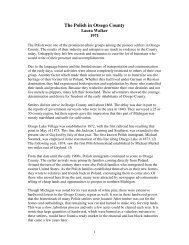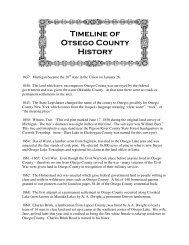Timeline - Chronology of Events - Otsego Community Connection
Timeline - Chronology of Events - Otsego Community Connection
Timeline - Chronology of Events - Otsego Community Connection
You also want an ePaper? Increase the reach of your titles
YUMPU automatically turns print PDFs into web optimized ePapers that Google loves.
<strong>Timeline</strong> <strong>of</strong><br />
<strong>Otsego</strong> County History<br />
1837: Michigan became the 26 th state in the Union on January 26.<br />
1840: The land which now encompasses <strong>Otsego</strong> County was surveyed by the federal<br />
government and was given the name Okkuddo County. Okkuddo is an Indian word meaning<br />
"sickly" or "stomach pains". It is unknown why this name was selected. At that time there were<br />
no roads or permanent settlements in the area.<br />
1843: The State Legislature changed the name <strong>of</strong> the county to <strong>Otsego</strong>; possibly for <strong>Otsego</strong><br />
County New York which comes from the Iroquois language meaning “clear water”, “rock”, or<br />
“the meeting place”.<br />
1850: Witness Tree: “This red pine marked June 17, 1850 during the original land survey <strong>of</strong><br />
Michigan. The tree’s diameter was eight inches at that time. The surveyor was William Burt.”<br />
This tree and interpretive sign stand near the Pigeon River County State Forest headquarters in<br />
Corwith Township. (note – Burt Lake in Cheboygan County was named for this surveyor)<br />
1854: David Ward, a lumber scout from Saginaw, traveled to the <strong>Otsego</strong> Lake area and was<br />
amazed at the fine stands <strong>of</strong> cork pine. He selected 16,000 acres <strong>of</strong> pine in what is now Hayes<br />
and <strong>Otsego</strong> Lake Townships and registered his claim at the land <strong>of</strong>fice in Ionia.<br />
1861 -1865: Civil War. Even though the Civil War took place before anyone lived in <strong>Otsego</strong><br />
County – therefore no one from <strong>Otsego</strong> County served in the war - many veterans <strong>of</strong> the Civil<br />
War were given land in <strong>Otsego</strong> County in recognition <strong>of</strong> their military service.<br />
1862: The Homestead Act was enacted which gave federal government to people willing to<br />
clear and settle in wilderness areas such as <strong>Otsego</strong> County. A list <strong>of</strong> 140 homestead patents<br />
granted to our pioneers can be found on pages 38-40 <strong>of</strong> the <strong>Otsego</strong> County centennial book.<br />
1868: The first attempt at a permanent settlement in <strong>Otsego</strong> County occurred along Crooked<br />
Lake (now known as Manuka Lake) by A. A. Dwight, a prominent Detroit lumberman.<br />
1869: Charles Brink, a lumberman from Lapeer County, was hired by A.A. Dwight to lead a<br />
team <strong>of</strong> 14 men to clear land and set up a camp at the southeast corner <strong>of</strong> <strong>Otsego</strong> Lake. His wife,<br />
Jane, arrived later that year and is credited as being the first white female to take up residence in<br />
<strong>Otsego</strong> County. Charles Brink Road is named in his honor.
1869: <strong>Otsego</strong> County lost a portion <strong>of</strong> land before<br />
its first settlers arrived. Hudson Township, which<br />
made up the northwest corner <strong>of</strong> <strong>Otsego</strong> County,<br />
was removed and added to Charlevoix to give it<br />
enough land to establish its own county<br />
government.<br />
1870: A. A. Dwight convinced the State<br />
Legislature to have the North Branch <strong>of</strong> the Au<br />
Sable River designated as a log driving stream and<br />
to have a state road built from Torch Lake to<br />
<strong>Otsego</strong> Lake. These accomplishments allowed the lumbering business to grow quickly.<br />
1871: The Great Chicago Fire created a huge demand for lumber to rebuild the city. As a result,<br />
exploration for white pine in northern Michigan increased dramatically.<br />
1872: <strong>Otsego</strong> Lake Village was established on the southeast corner <strong>of</strong> <strong>Otsego</strong> Lake by the<br />
lumbering firm <strong>of</strong> Smith, Kelley and Dwight. It was the first permanent settlement in the county.<br />
The village had several retail stores, a boarding house, an opera house, saloon, hotel, newspaper,<br />
post <strong>of</strong>fice, and school. Its population was 800 in 1884.<br />
1872: The Mackinaw Branch <strong>of</strong> the Michigan Central Railroad (also known as the Jackson,<br />
Lansing & Saginaw Railroad) reached <strong>Otsego</strong> Lake Village which is located at what is now the<br />
intersection <strong>of</strong> Old 27 south and Mancelona Road.<br />
1873: The community <strong>of</strong> Bradford Lake was established and was given a post <strong>of</strong>fice in 1876.<br />
The town was renamed Waters in 1885.<br />
1874: Berryville (3 ½ miles southwest <strong>of</strong> Vanderbilt) was established with the arrival <strong>of</strong> John G.<br />
and Mary (Elder) Berry and their four children from Detroit. The businessman built a school,<br />
store, water-powered grist mill, and sawmill.<br />
1875: <strong>Otsego</strong> County was established on March 12 and <strong>Otsego</strong> Lake<br />
Village was designated the county seat. The first four townships were<br />
<strong>Otsego</strong> Lake, Charlton, Livingston and Elmira Townships.<br />
1875: The “<strong>Otsego</strong> Herald News” began publication. Today, the<br />
newspaper is the “Gaylord Herald Times” and is published bi-weekly.<br />
1877: Corwith and Hayes Townships were established.<br />
1877: The county seat was moved from <strong>Otsego</strong> Lake Village to Barnes (later renamed Gaylord).<br />
1879: Dover Township was established.<br />
1881: Gaylord was incorporated as a village. It became a city in 1922.
1881: The Jackson, Lansing & Saginaw Railroad (Mackinaw Division <strong>of</strong> the Michigan Central<br />
Railroad) was extended to Vanderbilt from Gaylord.<br />
1882: Bagley Township was established.<br />
1882: County Poor Farm was established and located at Meecher and Allis Roads in Livingston<br />
Township. The facility closed in 1952 after 70 years <strong>of</strong> service.<br />
1883: The community <strong>of</strong> Elmira (originally named Windsor) was platted along the Grand<br />
Rapids & Indiana Railroad (later named the Penn Central Railroad) on the Antrim County line.<br />
The town is believed to have been named for Elmira, New York.<br />
1884: The Gaylord Masonic Lodge was chartered. In the early days <strong>of</strong> <strong>Otsego</strong> County, the<br />
Masonic Lodges played a vital role in the social life <strong>of</strong> the community. Charity Lodge #403 in<br />
Elmira consolidated with the Gaylord Lodge in 1918. Alpha Lodge in Johannesburg<br />
consolidated with the Gaylord Lodge in 1918. Cyrene Lodge #352 in Vanderbilt consolidated<br />
with the Gaylord Lodge in 1995 and the Lodges became known at Gaylord Cyrene Lodge #366.<br />
1888: Chester Township was established.<br />
1891: The brick courthouse (photo to the<br />
left) was built in downtown Gaylord. The<br />
land was donated by Orlando M. Barnes,<br />
secretary <strong>of</strong> the railroad company.<br />
However, if the property was no longer<br />
used for county purposes, it would revert to<br />
Mr. Barnes or his heirs. Seventy-six years<br />
later, the old brick was torn down and<br />
replaced in 1967 with the City/County<br />
Building.<br />
1894: The Gaylord branch <strong>of</strong> Dayton Last Block Works (DLBW) opened. The enterprise<br />
consisted <strong>of</strong> 27 buildings and covered 14 ½ acres. At its peak, DLBW had 100 employees. This<br />
factory was once the largest <strong>of</strong> its kind in the world.<br />
1901: Johannesburg was established by the Johannesburg Manufacturing Company, a large<br />
sawmill operation that specialized in hemlock and hardwood lumber. The community was<br />
named after Johanna Hanson Bay. Johanna’s brother, (not husband) Rasmus Hanson, was the<br />
president <strong>of</strong> the Johannesburg Manufacturing Company.<br />
1901: The Village <strong>of</strong> Vanderbilt was incorporated. The community was named for railroad<br />
executive Cornelius Vanderbilt <strong>of</strong> New York who, after harvesting the timber, gave the land to<br />
the local residents.
1901: St. Mary Catholic Church (second church building on that site) was completed and<br />
dedicated on the southwest corner <strong>of</strong> <strong>Otsego</strong> Avenue and Mitchell Street in Gaylord. Today, the<br />
red brick landmark is the Mt. Carmel Centre and is used for performing arts. A state historical<br />
marker was unveiled in 2005.<br />
1904: The Boyne City, Gaylord & Alpena Railroad extended from Elmira to Gaylord. By 1918<br />
it was completed and reached its destination <strong>of</strong> Alpena. This provided an important east-west<br />
transportation route and included stops at Hallock, Sparr, Gibbs, and Vienna.<br />
1905: The cannon on the courthouse<br />
lawn was dedicated in memory <strong>of</strong><br />
the Civil War veterans. It was one<br />
<strong>of</strong> 26 cannons used on Admiral<br />
Farragut’s flagship “Hartford”.<br />
1910: Gaylord Motor Car Company was established and went bankrupt in 1913. Approximately<br />
350 cars were manufactured during its four years <strong>of</strong> business. The only known Gaylord Car in<br />
existence is on display at the Gaylord – <strong>Otsego</strong> County Chamber <strong>of</strong> Commerce Visitors’ Center.<br />
1912: Gaylord Municipal Building was built on Court Street to the immediate east <strong>of</strong> the County<br />
Courthouse. It housed city <strong>of</strong>fices, library, police and fire departments, and an auditorium.<br />
1913: The community <strong>of</strong> Sparr was established along the route <strong>of</strong> the Boyne City, Gaylord, and<br />
Alpena Railroad. The town was named for local minister and farmer, Philip Sparr.<br />
1913: Gaylord’s Main Street was paved.<br />
1913: Ten years after the Wright brothers successful flight, the first airplane flew into <strong>Otsego</strong><br />
County.<br />
1917: Seven elk were transplanted near Wolverine in Cheboygan County and eventually<br />
migrated to the Pigeon River State Forest in northeast <strong>Otsego</strong> County.<br />
1917: The Extension Service <strong>of</strong>fice was established in <strong>Otsego</strong> County. Its educational activities<br />
focused on agriculture, home economics, community development, and 4-H youth programs.<br />
1917: Ray Muscott <strong>of</strong> Waters, Michigan received a US Patent on June 27 for a motor sleigh -<br />
the forerunner <strong>of</strong> today’s snowmobile.<br />
1918: The Farm Bureau in <strong>Otsego</strong> County was organized.
1919: George Doumas purchased The Sugar Bowl – a candy store and sweet shop -- in<br />
downtown Gaylord. It was later expanded into a full-service restaurant and is one <strong>of</strong> the oldest<br />
family-owned businesses in <strong>Otsego</strong> County.<br />
1920: <strong>Otsego</strong> Lake State Park was established on the east side <strong>of</strong> <strong>Otsego</strong> Lake. The property<br />
was purchased from a lumber company who had lumbered it <strong>of</strong>f.<br />
1923: Sawyer Township was established. It was created from the eastern portion <strong>of</strong> Dover<br />
Township. Sawyer Township existed until 1934 when it consolidated with Charlton Township.<br />
1926: The first golf course opened in <strong>Otsego</strong> County – Gaylord Country Club – and was located<br />
near the present day K-Mart shopping center. It moved to Elmira Township in 1971.<br />
1927: Dr. Gordon McKillop opened a 12 bed hospital on the second floor <strong>of</strong> his home located in<br />
Gaylord on the northeast corner <strong>of</strong> Main and Oak Streets. The hospital closed in 1936.<br />
1928: US 27 – the main north south highway - was paved.<br />
1928: The Mackinac and Au Sable State Forests were created. These two state forests cover a<br />
total <strong>of</strong> several hundred acres in Charlton, Chester, Hayes and <strong>Otsego</strong> Lake Townships.<br />
1929: The Great Depression began<br />
1932: Dearborn Colony in Charlton Township was established with 8 families relocated from<br />
Dearborn Michigan to 140 acre farms in eastern <strong>Otsego</strong> County. This “back to the farm”<br />
experimental relief program by the Dearborn Welfare Department only lasted a short time.<br />
1934: Gaylord Kiwanis Club was formed with 35 members and Frank Shipp its first president.<br />
1936: The first ski hill to<br />
operate in <strong>Otsego</strong> County - The<br />
Vanderbilt Ski Club - began<br />
operation. It moved to the<br />
Hidden Valley location in 1947<br />
and became the <strong>Otsego</strong> Ski<br />
Club.<br />
1936: The Gaylord High School<br />
gymnasium was built <strong>of</strong> field<br />
stone by the WPA and CCC.<br />
The building is located on South<br />
Center Street and is now the<br />
<strong>Otsego</strong> County <strong>Community</strong><br />
Center.
1937: The Northern<br />
Michigan Tuberculosis<br />
Sanitarium opened its 128-bed<br />
facility in Livingston<br />
Township. The four-story<br />
Sanitarium and its five<br />
accessory buildings occupied<br />
the 160 acre complex located<br />
1 mile north <strong>of</strong> Gaylord. It<br />
later became a State Hospital<br />
for the mentally handicapped<br />
and named the Alpine Center.<br />
It closed in 1980 which was a<br />
loss <strong>of</strong> 200 jobs. (See 1981<br />
for an update on this facility)<br />
1939: Rural Electric Association (REA) brought electricity to rural county residents.<br />
1940: <strong>Otsego</strong> County Chamber <strong>of</strong> Commerce was established.<br />
1941 – 1945: World War II had a major impact on <strong>Otsego</strong> County. In 1942, Dr. Robert<br />
Oppenheimer met with summer resident Dr. Arthur Compton at the <strong>Otsego</strong> Lake State Park to<br />
secretly discuss their scientific research that was related to the atom bomb later used in WWII.<br />
1941: Higgins Industries – now H&H Tube -- opened a manufacturing plant in Vanderbilt.<br />
1942: <strong>Otsego</strong> Ski Club opened. In 1955, Alan Gornick purchased the resort from the estate <strong>of</strong><br />
Donald McLouth. Today, the 4000 acre resort has 105 guest rooms, 2 golf courses, ski hill, and<br />
restaurant. The resort was also known as Hidden Valley.<br />
1945: Standard Products opened in Bagley Township.<br />
1950: WATC, the county’s first radio station, began broadcasting its AM station.<br />
1951: Glen’s Market opened its first store. C. Glen and Doris Catt founded the company that<br />
eventually expanded to 26 stores with 2500 associates. It was sold in 1998 to Spartan Foods.<br />
1951: <strong>Otsego</strong> County<br />
Memorial Hospital opened<br />
with 34 beds. (At some point<br />
in time, the word County was<br />
dropped from its name).There<br />
hadn’t been a hospital in the<br />
county for the past 15 years<br />
since the McKillop Hospital<br />
closed in 1936.
1956: “Our Hometown”, Vanderbilt’s newspaper began its weekly publication.<br />
1956: Gaylord Rotary Club was chartered.<br />
1957: The Mackinac Bridge opened. It connects Michigan’s two peninsulas.<br />
1958: The Gaylord Industrial Development Corporation was formed.<br />
1960s: Michaywe’ land development was formed. The 2000 acre planned unit development<br />
(PUD) includes 750 homes, 2 golf courses, and a clubhouse.<br />
1962: The completion <strong>of</strong> I-75 through <strong>Otsego</strong> County contributed to the increase in tourism.<br />
Restaurants, gas stations, motels, resorts and recreation areas have benefited from being located<br />
on this new, major transportation route.<br />
1963: The <strong>Otsego</strong> County Historical Society was established.<br />
1964: Alpine Motif was introduced to downtown Gaylord by local businessman Gordon Everett.<br />
1965: U.S. Plywood opened a manufacturing plant in Gaylord. The firm originally<br />
manufactured particle board under a Swiss patent. U.S. Plywood merged with Champion<br />
International in the1970s and later became part <strong>of</strong> Georgia-Pacific Corporation (G-P). In late<br />
2005, Koch Industries purchased G-P. The plant in Gaylord closed on March 6, 2006.<br />
1965: The first Alpine Festival, later renamed Alpenfest, was held in Gaylord. This community<br />
celebration honors its sister city Pontrasina, Switzerland and provides a week long <strong>of</strong><br />
entertainment for local residents as well as attracting thousands <strong>of</strong> visitors.<br />
1965: Countywide zoning was<br />
enacted<br />
1967: City / County Building was<br />
built in downtown Gaylord.<br />
1968: Johannesburg School and Lewiston School consolidated to form the Johannesburg-<br />
Lewiston Area Schools. The elementary school is located in Lewiston and the high school is in<br />
Johannesburg. The district covers 291 square miles.<br />
1971: The Gaylord Air Industrial Park west <strong>of</strong> I-75 on Dickerson Road was developed.<br />
1971: Gaylord became the smallest diocese city in the United States. The Roman Catholic<br />
Diocese <strong>of</strong> Gaylord was created and includes 21 counties in the northern half <strong>of</strong> the Lower<br />
Peninsula. Edmund Szoka was its first bishop,.
1971: Big Lake School, the last <strong>of</strong> the more than 40 one-room schools in <strong>Otsego</strong> County, closed<br />
and consolidated with Gaylord <strong>Community</strong> Schools. The building was renovated and is now<br />
used as the Chester Township Hall.<br />
1972: United Way was established in <strong>Otsego</strong> County.<br />
1973: The Pigeon River County Advisory Council was created to help manage the large tract <strong>of</strong><br />
state owned land located in <strong>Otsego</strong>, Cheboygan, and Montmorency Counties.<br />
1974: McDonald’s became the first fast food restaurant in <strong>Otsego</strong> County.<br />
1981: Alten Zimmer was built with 46 apartments for senior citizens and expanded to a total <strong>of</strong><br />
70 housing units in 1985.<br />
1981: RSVP (Retired and Senior Volunteer Program) was established in <strong>Otsego</strong> County.<br />
Cynthia Sparks was the first executive director.<br />
1981: The Alpine Center re-opened after renovating the former TB Sanitarium (see 1937). The<br />
160 acre complex was named in honor <strong>of</strong> long time County Commissioner, J. Richard Yuill <strong>of</strong><br />
Corwith Township. Today the Center is the site <strong>of</strong> the Gaylord High School, The University<br />
Center at Gaylord, M-TEC Kirtland – Gaylord, and various county, state, and federal agencies.<br />
1981: The first “big box” chain store opened in <strong>Otsego</strong> County. K-Mart opened a retail store at<br />
the corner <strong>of</strong> Old 27 South (<strong>Otsego</strong> Avenue) and Grandview Blvd. in Gaylord.<br />
1982: The first <strong>of</strong>ficially designated centennial farm in<br />
<strong>Otsego</strong> County was the farm <strong>of</strong> Albert (Bob) and Anna<br />
Kassuba. The 3 rd generation farm located in Bagley<br />
Township was established in 1882 by Al’s grandfather,<br />
Frank Kassuba, Sr. who moved here from Germany.<br />
1982: Green Timbers in Corwith Township was sold to the State <strong>of</strong> Michigan and added 6000<br />
acres to the Pigeon River County State Forest.<br />
1984: First special elk hunt since 1965 was conducted.<br />
1985: The <strong>Otsego</strong> County Library moved from its location at the Courthouse to 700 W. <strong>Otsego</strong><br />
Avenue in Gaylord. There are branch locations in Vanderbilt and Johannesburg.<br />
1986: County voters defeated a zoning request for the proposed Borden chemical resin plant.
1986: Former-President Jimmy Carter shopped at the Alpine IGA for supplies during his<br />
hunting excursion to the Pigeon River Country Sate Forest.<br />
1986: Gaylord Area Convention and Tourism Bureau was created. The bureau is funded by a<br />
room assessment fee paid by guests <strong>of</strong> area hotel, motels, and resorts.<br />
1987: <strong>Otsego</strong> County celebrated Michigan’s Sesquicentennial with a variety <strong>of</strong> events through<br />
out the year. Interest in local history grew and resulted in reactivating the Historical Society.<br />
1987: U.S. Plywood was sold to Georgia-Pacific, the largest forest wood products corporation in<br />
the nation.<br />
1988: Project Nature opened near Vanderbilt.<br />
1989: AREC (Alpine Regional Educational Center) was established as a consortium <strong>of</strong> colleges.<br />
It became the University Center at Gaylord in 2002.<br />
1990: Wal-Mart opened in the White Pine Shopping Center located on M-32 West in Bagley<br />
Township.<br />
1992: The Friendship Center began operation. The facility provides temporary housing for<br />
homeless people. Originally located at <strong>Otsego</strong> Memorial Hospital and then the Alpine Center<br />
(Christianson Building) it moved in 1997 to a former motel on Old 27 South across from the<br />
<strong>Otsego</strong> Lake State Park.<br />
1992: The <strong>Otsego</strong> County Historical Museum opened on Main Street in downtown Gaylord.<br />
1993: The "new" high school for Gaylord <strong>Community</strong> Schools was constructed at the Alpine<br />
Center in Livingston Township. The gymnasium was named in honor <strong>of</strong> long-time coach Jim<br />
Mongeau. The auditorium was named in honor <strong>of</strong> Alan Gornick.<br />
1994: Bottle Cap Museum featuring Coca-Cola memorabilia opened in Sparr.<br />
1995: The National Weather Service was built 2 miles northwest <strong>of</strong> Waters on Passenheim Road<br />
in <strong>Otsego</strong> Lake Township.<br />
1996: The <strong>Otsego</strong> County Sportsplex opened. Located on Gornick Avenue, the recreation<br />
facility is funded by a county special millage and provides an indoor swimming pool and ice<br />
rink.<br />
1997: The Volunteer Center <strong>of</strong> <strong>Otsego</strong> County was established.<br />
1998: Winds exceeding 100 miles per hour caused $10 million in damages. Portions <strong>of</strong> <strong>Otsego</strong><br />
County were declared a disaster area.
2000: A statue <strong>of</strong> Claude E. Shannon was unveiled at a<br />
dedication ceremony on October 6 in the Claude Shannon<br />
Park in downtown Gaylord. Shannon was a 1932 graduate<br />
<strong>of</strong> Gaylord High School who went on to a distinguished<br />
academic career in electronic communications. He is known<br />
as the father <strong>of</strong> the Information Theory.<br />
2000: As the result <strong>of</strong> a Gaylord/<strong>Otsego</strong> County Chamber<br />
<strong>of</strong> Commerce Task Force investigation, the <strong>Otsego</strong> County<br />
Economic Alliance was established. Its first executive<br />
director, Jeff Ratcliffe, was hired in 2001.<br />
2001: Pavilion on Court was constructed east <strong>of</strong> the<br />
Courthouse over Court Street between Main and First and<br />
used for special events such as the Farmers Market and<br />
seasonal festivals.<br />
2002: The University Center at Gaylord and Kirtland M-TEC – Gaylord opened its classroom<br />
doors to students.<br />
2004: “One County-One Vision” a year long community visioning process undertaken by<br />
community leaders to explore <strong>Otsego</strong> County’s future.<br />
2004: The Edelweiss Village Shopping Center opened on Dickerson Road at the I-75 exit 282.<br />
Retail stores include Super Wal-Mart, Lowe’s, and Radio Shack.<br />
2006: The roundabout on Old 27 North at the Alpine Center entrance was constructed<br />
2007: Thunder Over Waters began its annual Labor Day weekend celebration.<br />
2008 “Mistaken Identity” was published and gained national<br />
media attention. The book told the story <strong>of</strong> a multi-vehicle traffic<br />
accident that took place in 2006 involving Gaylord native<br />
Whitney Cerak. Initially, it was believed that Whitney had been<br />
killed. However, five weeks later as she was recovering from<br />
injuries and in a coma, it was discovered that she had been<br />
mistaken for another passenger, Laura Van Ryn.<br />
2008: Gaylord built its new City Hall at 305 W. Main Street.<br />
2010: War Memorial in downtown Johannesburg was unveiled.<br />
2012: The <strong>Otsego</strong> County Louis M. Groen Nature Preserve<br />
opened in Charlton Township. The 764 acre property was once<br />
the site <strong>of</strong> the Johannesburg Manufacturing Company and later Echo Valley Resort.<br />
Last Revised: October 9, 2012
Sources <strong>of</strong> Information<br />
1. Clear Water Land: A history <strong>of</strong> <strong>Otsego</strong> County for Michigan’s Sesquicentennial,<br />
Supplement to the Gaylord Herald Times, August 20, 1987<br />
2. Days Gone By: A Photographic History <strong>of</strong> <strong>Otsego</strong> County. A special publication <strong>of</strong> the<br />
Gaylord Herald Times. January 2007<br />
3. Douglas Lake: The geological and historical story <strong>of</strong> one lake in <strong>Otsego</strong> County <strong>of</strong> the<br />
lower peninsula <strong>of</strong> Michigan. Eugene Oshner 1989<br />
4. Early Life in the Johannesburg Area, by Wayne B. Welch, 1988<br />
5. 1875-1975 Commemorative Centennial Edition: <strong>Otsego</strong> County’s First One Hundred<br />
Years. <strong>Otsego</strong> County Herald Times, August 21, 1975<br />
6. Gaylord <strong>of</strong> Today – Souvenir Edition, <strong>Otsego</strong> County Herald September 15, 1905<br />
7. Gaylord/<strong>Otsego</strong> County Chamber <strong>of</strong> Commerce 50 th Anniversary 1940-1990,<br />
Supplement to the Gaylord Herald Times, February 8, 1990<br />
8. Ghosts <strong>of</strong> the North: Railroads <strong>of</strong> <strong>Otsego</strong> County. Charles R. Conn and Rick Packman.<br />
1991. Revised 1992<br />
9. A History <strong>of</strong> <strong>Otsego</strong> County. Researched and written by William H. Granlund. Edited<br />
by William R. Shirley. Unpublished manuscript. 1983<br />
10. Learning A Living: 90 Years <strong>of</strong> Extension Work in <strong>Otsego</strong> County Michigan. Philip J.<br />
Alexander. Unpublished manuscript. 2007<br />
11. Michigan: A Guide to the Wolverine State. (1941) WPA – Michigan State<br />
Administrative Board<br />
12. Michigan Ghost Towns <strong>of</strong> the Lower Peninsula. (1970) R.L. Dodge<br />
13. Michigan Place Names. Walter Romig 1986<br />
14. <strong>Otsego</strong> County: The hub <strong>of</strong> northern Michigan. <strong>Otsego</strong> County Board <strong>of</strong> Commissioners<br />
1983<br />
15. <strong>Otsego</strong> County Centennial Book, 1975<br />
16. <strong>Otsego</strong> County Master Plan, 1997 and 2007<br />
17. <strong>Otsego</strong> County Pictorial History. Turner Publishing Company. <strong>Otsego</strong> County Historical<br />
Society, 2002<br />
18. <strong>Otsego</strong> County Progress: Gaylord Centennial 1881-1981, Supplement to the Gaylord<br />
Herald Times, October 1, 1981<br />
19. The Pigeon River Country. Dale Clarke Franz. 1985 Revised Edition 2007<br />
20. Soil Survey <strong>of</strong> <strong>Otsego</strong> County Michigan, USDA NRCS, 2005<br />
21. Sown On Good Ground: Centennial History <strong>of</strong> St. Mary Cathedral Parish, Gaylord.<br />
Sister Alice O’Rourke, O.P. 1984<br />
22. A Step Back in Time Volume 1, <strong>Otsego</strong> County Historical Society, Compiled by Beth<br />
Warner and Patricia Gilardy. No date<br />
23. A Step Back in Time Volume 2, <strong>Otsego</strong> County Historical Society, Compiled by Beth<br />
Warner and Patricia Gilardy. No date<br />
24. A Step Back in Time Volume 3, <strong>Otsego</strong> County Historical Society, Compiled by Dorothy<br />
Jensen. 2002-2003<br />
25. Tomorrow’s Saturday. Shirley Glidden 1971<br />
26. The Unfinished History <strong>of</strong> <strong>Otsego</strong> County. William Granlund. Unpublished manuscript.<br />
1991
Museum Location: 320 W. Main Street<br />
Gaylord, Michigan<br />
Mailing Address: P.O. Box 1223<br />
Gaylord, MI 49734<br />
Phone: 989-732-4568<br />
Email: OCHSmuseum@gmail.com<br />
Web: www.otsego.org/ochs







